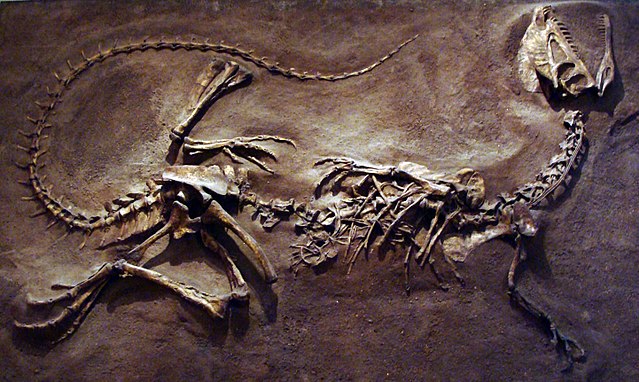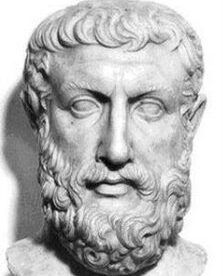
Dilophosaurus on display at the Royal Ontario Museum
Available from Amazon, Thriftbooks, and Abebooks
Book Length: 277 pages
Among many alleged proofs, Darwin’s disciples have a great fondness for the fossil record, which for them seems to be a treasure trove of reliquaries confirming their ideas. However, as noteworthy Creationist Duane T. Gish explains in this book, when this record is critically examined, the concept of origins challenged by its existence is not that of Creationism, rather (and quite ironically) Evolutionism.
Gish wisely structures his examination of the fossil record not as some kind of battle between religion and science, but instead as two competing worldviews—Creationism and Evolutionism—and asks his reader this simple question: which one is vindicated by the vast record we now possess of life on earth? By referring to debates within the scientific literature itself concerning the failure of the fossil record to produce the transitional species prophesied by Darwin, he advances his argument in a way approachable even to skeptics of Creationist thought. Moreover, in strengthening his critique in this manner, the author also provides Creationists with additional information and insights which will only aid efforts to pull the mask off this outrageous deception, a deception that has poisoned both the hearts and minds of men for a little under two hundred years.
One example of a significant “gap” in the fossil record provided in this book is the one that lies between the dinosaurs and a supposedly earlier organism. This organism was and still is commonly presumed to be among the psuedosuchians, [lit. “false crocodiles”] an extinct group of reptiles that possessed mammalian traits, a presumption which contradicts the very timeline proposed by the Evolutionists.
Gish writes:
In an article entitled “Mysteries of Early Dinosaur Evolution,” [paleontologist Barry] Cox states, “Although many pages have been written discussing the mystery of the extinction of the dinosaurs, almost as much uncertainty surrounds their origin-or origins.”
As pointed out earlier, it is assumed that dinosaurs evolved from psuedosuchians. One problem with this notion is that the assumed psuedosuchian ancestors were still present after the dinosaurs had evolved. Thus, Cox says “Throughout the late Triassic, at least, a variety of psuedosuchians therefore coexisted with a variety of their presumed descendants, the dinosaurs.”
(120)
It is seemingly incredible that this subtle contradiction in the Evolutionist narrative of earth history still persists, even after the forty or so years which separates the publication of this book to the present year. Whether it is in animated documentaries or picture books, the “first dinosaurs” by the Evolutionists are typically presented as being Coelophysis, a diminutive and nimble carnivore, and the comparatively much more intimidating man-sized predator Herrerasaurus; yet even in these illusory depictions these “pioneers” are shown living alongside their alleged ancestors! Such a grievous oversight illustrates, as with many other examples Gish uses, that the massive flaws in the Darwinian interpretation of the fossil record still have not been adequately rectified. Quite helpful to the reader is a chart provided within the book that illustrates the astounding number of these gaps, which assists one in comprehending the immense scale of these (still) missing links.
Of course, it is not enough to debunk case examples of animals which have been nominated and thereafter trotted out as fulfilling Darwin’s prophecy—one must undermine the faulty reasoning that lies within. Attacking how Evolutionists classify animals in the fossil record as “transitional”, Gish points out the embarrassingly self-serving logic of the Darwinist, a logic which loves to utilize composition fallacies as proof of its bold claims. Utilizing the example of the platypus, a creature thankfully still extant, he proves that understanding such seeming oddities as “mosaic animals” is far more sensible than the “transitional animal” concept:
This creature is a mammal, and yet it has a duck-bill, webbed feet, and lays eggs, in addition to possessing other characteristics that might be called reptilian. It has characteristics of mammals, reptiles and birds, and perhaps could be called a “primitive” mammal. It could not possibly be ancestral to mammals, however, because it appeared very recently, about 150 million years too late to be the ancestor of mammals! In fact, this unique combination of structural features renders it impossible to suggest that it arose from any particular class of vertebrates or that it could have been an intermediate between two classes.
(93)
Another point which renders the “transitional species” category a simple absurdity is the fact that, as Gish repeats throughout this book, all the alleged transitional animals possess organs and limbs for which they certainly would have had a use. This runs contrary to the Darwinian expectation that fossils would be found which would show limbs and organs in the process of developing, thus granting them a kind of photograph of evolution in process. They have been searching for such evidence for well over a hundred and fifty years, and it will never be found because such a concept is ridiculous in of itself. How would a half-wing or a half-arm give an individual specimen of a given species an advantage over its competition? This malformed specimen—malformed indeed; for if we were to gaze our eyes on such a creature, we would be inclined to call it such—how could such a creature be “selected” by nature for reproduction? These fully-formed creatures discovered in the fossil record, therefore, lend credence to the Creationist concept of origins, for this concept postulates “an explosive appearance in the fossil record of highly complex forms of life without evidence of ancestral forms” (41).
Various other problems within Evolutionary theory are given ample coverage in Gish’s thorough evaluation, such as the issue of the evolution of flight and the evolution of soft-bodied animals into hard-bodied ones. Furthermore, the proposed ancestors of mankind are given considerable examination, as the section on this topic in the book takes over half its length and is well worth reading, as in those pages Gish irrefutably demonstrates that these “ape-men” were either apes or men, reviewing the case of each one by one. Another noteworthy point is that the author does well in his undermining of the proposed millions of years myth, although this is not the main subject of the book and does not take up much space in the text. It is a sensible inclusion, considering that the faulty Evolutionist interpretation of the fossil record rests much upon Lyellian geology and its heirs. However, there seems to be at least one oversight in this book concerning the proposed ancestor of whales, for he does not address the claim of some extinct form of wolf being this “missing link”. But this does not undermine his overall argument, as one can utilize his reasoning to dismantle this foolish proposition.
This is a truly worthwhile book for Catholics who wish to examine one of the major foundational flaws in Darwinian thinking, and to see how the scientific community has shamefully sought to cover up these flaws instead of humbly acknowledging the failure of this model. Gish comments sagely on this intellectual dishonesty in writing that, “no matter what the data may be, the theory can be bent sufficiently to make everything fit” (137). Despite the author’s allegiance to Protestantism, he does not attack the Catholic Faith in this work. In fact, he favorably references Rev. Patrick O’Connell in his examination of the Sinathropus, which draws upon the account of events this priest presented in his book Science of Today and the Problems of Genesis. The brief parts of the book in which Gish presents his interpretation of the sacred book of Genesis seem to align with the traditional teaching of the Church on this matter, though I, the reviewer, am an inadequate judge as I am a simple layman. These sections are interesting, but one should keep in mind that since they were composed by a Protestant that they should be taken with a proverbial grain of salt—weigh anything he says on matters of religion in comparison with the unerring teaching of Holy Mother Church. As an aside, the occasional humorous remarks made by the author in the text only serve to enhance, not diminish it, instead adding more humanity into what otherwise may at first seem to be a dull scientific work. Though I am sure that there more recent Creationist books which utilize the tools and discoveries of contemporary science and tackle the present Darwinist discourse, this book ought to be held in high regard for its superb quality and wealth of information.
